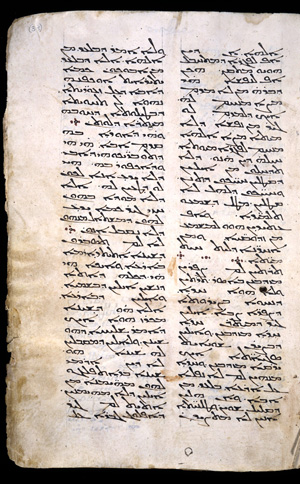 |
Saint Ephrem's commentary on Tatian's Diatessaron Dublin, Chester Beatty Library, MS. W 709, f. 37v Ink on parchment; ff. 75; 250 x 165mm Ephrem, Evangelion Da-Mehallete; Syriac Deir el-Surian, Egypt; ca. 480-500 |
||
|
The Diatessaron, meaning "through the four gospels," is the name the fourth-century Church historian Eusebius gave to a collation and combination of the gospels created by Tatian, a disciple of Justin Martyr, around 170 C.E. In this work, Tatian drew on the four canonical gospels to create a single, continuous narrative of Jesus's life that eliminated repetition of parallel passages and harmonized discrepancies and contradictions. Probably written in Tatian's native Syriac, the Diatessaron is one of the earliest witnesses to the text of the gospels, drawing on a form of the Greek text circulating in Rome in the mid-second century. It probably influenced many readings in the Old Syriac version of the New Testament, and enjoyed great popularity both within the Syriac- and Aramaic-speaking world and much farther afield. Not long after composing the Diatessaron, Tatian came to be considered a heretic, and by the mid-fifth century his work was finally suppressed. Despite its enormous popularity and influence, no copy of the original text has survived, and reconstructions have necessarily drawn on translations, commentaries, and quotations. Among the most important of these was a commentary written by Ephrem of Edessa (ca. 306-373), a theologian who settled in this important center of Christianity (now Urfa in eastern Turkey). Until the late 1950s, Ephrem's commentary was available primarily through an Armenian version first published in the nineteenth century. It was then that Sir Alfred Chester Beatty, who had already assembled a remarkable collection of early biblical papyrus codices, acquired a manuscript containing a significant portion of the Syriac text of Ephrem's commentary. This was published in 1963 by Dom Louis Leloir, who had completed a critical edition of the Armenian version in 1953 and a Latin translation in 1954; a stray folio of the same manuscript now in Barcelona was published in 1966. Even more remarkably, the Chester Beatty Library acquired an additional five folios of the manuscript in 1984 and a further thirty-six in 1986. Approximately eighty percent of the original codex has now been reassembled, and a critical edition of the text and English translation have already been published. AG (author bios) Bibliography: Leloir, 1963; Leloir, 1990; McCarthy, 1993; Petersen, 1994; Petersen, 2004; Valdivieso, 1966. |
|||